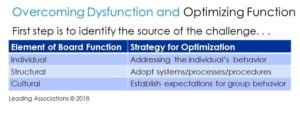 A board has little hope of providing effective governance, let alone visionary and strategic leadership, if it’s still held back by some basic sources of dysfunction.
A board has little hope of providing effective governance, let alone visionary and strategic leadership, if it’s still held back by some basic sources of dysfunction.
The key to overcoming dysfunction and optimizing function is to first identify the source of the challenge. Functional challenges fall into three main categories – Individual, Structural and Cultural –which often work in combination with each other.
Most of the resources on improving board effectiveness tend to focus solely on the structural aspect of governance – policies, procedures, Roberts Rules of Order, bylaws, statute, fiduciary duty, etc. – for overcoming dysfunction. But it’s the human element that’s the real challenge. How well board members play in the sandbox together is far more important than processes, policies and procedures – which are often completely ignored in the heat of battle.
There are key strategies, each different, for addressing the three categories of dysfunction:
Individual challenges > address the individual’s behavior directly
Structural challenges > put the needed structures/policies/processes in place
Cultural challenges > adopt group expectations and norms of engagement
In reality, most board challenges contain elements of all three categories. All three may be – and usually are – present, reinforcing each other. The key to solving the challenge is identifying the primary category driving the dysfunction and address it first.
Here are examples with all three elements present, with the primary driver listed first:
Individual: A single divisive individual joining an otherwise united board might create a factional cultural dynamic in response to the individual’s behavior. The board might also have inadequate structural mechanisms in place to address such behavior – written policies, procedures, norms of engagement— due to a history of harmony and perceived lack of need.
Cultural: A board with a “shiny object” culture (i.e., they pursue every “good idea” board members suggest) might follow a charismatic individual’s personal agenda, which is not aligned with the organization’s mission. Further, no structure exists – such as a Strategic Plan – to help prevent such distractions.
Structural: A board with a constituency-based structure (i.e., fixed geographic or special interest representation), might evolve a divided/parochial culture in which an individual board member believes their fiduciary responsibility is to the constituency they represent and not to the organization as a whole, lobbying for disproportionate resources and special attention.
boardpuzzelIn the first example, if the board addressed the divisive individual’s behavior directly, the need to address the cultural and structural dynamics arising in response to the behavior might be mitigated or eliminated.
In the second example, if the board came to a group agreement to adopt a mission-driven, strategy-focused culture, followed by adopting a Strategic Plan, it would improve its ability to say “no” to an individual’s personal agenda that doesn’t fit the mission/strategic focus.
In the final example, if the board were to adopt a competency-based selection process vs. fixed constituency-based representation, the confusion over who board members represent – a constituency vs. the organization as a whole – could be eliminated.
While a board will have to do more work to identify specific solutions within the categories, the Individual, Structural, Cultural Assessment is a simple, yet highly effective diagnosis tool, which creates a basic framework for identifying, and a starting point for addressing, virtually any kind of board dysfunction.

